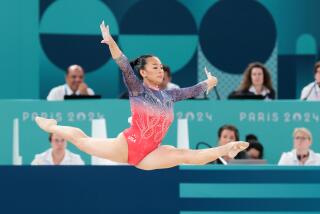U.S. OLYMPIC GYMNASTICS TRIALS : UCLA’s Keswick, Waller Are 1-2
BALTIMORE — Memories of the 1984 men’s Olympic gymnastics trials were rekindled at the Baltimore Arena Friday night.
Back then, a contingent of UCLA athletes finished 1-2-3 and went on to help the United States win its first gold medal in team competition.
“At the trials it was me, Tim (Daggett) and Mitch (Gaylord),” Peter Vidmar said. “This time, we are 1-2.”
Vidmar and Daggett were two of 5,134 spectators who watched Scott Keswick and Chris Waller, former teammates and best friends, perform solid routines with seeming ease to finish the compulsory competition 1-2, ahead of a group of 20.
“After I nailed the vault I had a feeling about that 1984 team,” Waller said. “Chainey (Umphrey, also of UCLA) was in sixth place then, and I thought, ‘It’s starting to look like ’84 all over again.’
Then, for a moment I thought, ‘Are we that good?’
“And then I answered, ‘Yes, I think we are.’ ”
The outcome will depend on how well Keswick, 22, and Waller, 23, do in tonight’s optional competition, when the top six finishers will make the Olympic team and the seventh place finisher will serve as an alternate. But with the compulsories counting 60% of the score and the optionals 40%, both are in good position to make the squad.
Keswick was consistent from the start, hitting all his routines to score 83.346. Ranked No. 2 in the country, Keswick competed with No. 1 John Roethlisberger through the first three rotations before taking the lead for good when Roethlisberger fell off the parallel bars.
“I have never felt better about a meet in my life,” said Keswick, who is from Las Vegas. “I have been competing at UCLA for four years and this last year have had the chance to compete in a lot of meets, and so I have just been fine-tuning.
“I was ready for this meet two weeks ago.”
Waller, from Mt. Prospect, Ill., and ranked No. 4, moved into the second spot after the third rotation and finished with 82.860. Dominick Minicucci, who was on the 1988 U.S. Olympic team, and Roethlisberger finished a close third and fourth, respectively.
For a while it seemed Umphrey would finish in the top six. But he faltered on his last event, the horizontal bar, and dropped to 10th with 81.576.
This was Umphrey’s first competition since October, when he broke a bone in his foot and was out for the college season.
The crowd favorite was Kurt Thomas, who is attempting a comeback after 12 years. At 36, divorced twice and retired once, Thomas is 16 years older than the youngest competitors and nine years older than the next oldest, Charles Lakes of Newhall.
But here Thomas was, spiked hair and all, performing respectively if not spectacularly. He is ranked 16th in the country and finished 16th in compulsories.
“It’s my best compulsory score so far in my comeback, but I have a lot to make up,” Thomas said. “I’ve always said it’s a longshot. I’m the sentimental favorite for the thirtysomething and older generation.”
The most applause for Thomas came when he performed the Thomas Flairs during his floor exercise, a move he made famous in 1978 when he won the floor event and became the first American in 46 years to win a gold medal at a World Championships.
“To show you how much the sport has changed, now doing the Thomas Flairs on the floor exercise is a required move in the compulsories,” Vidmar said. “But, hey, I admire him. He’s the best 36-year old gymnast on the planet.”
Trial Notes
Kim Zmeskal, who trails Shannon Miller by 0.26 going into today’s optional competition, could beat Miller soundly and still not win the meet. It’s all because of a complicated scoring system that is so difficult to explain that gymnast Hilary Grivich said: “You don’t have to be a mathematician to figure it out, you have to be a genius.” . . . 1988 Olympian Charles Lakes finished last in compulsories, scoring 79.260.
More to Read
Go beyond the scoreboard
Get the latest on L.A.'s teams in the daily Sports Report newsletter.
You may occasionally receive promotional content from the Los Angeles Times.






